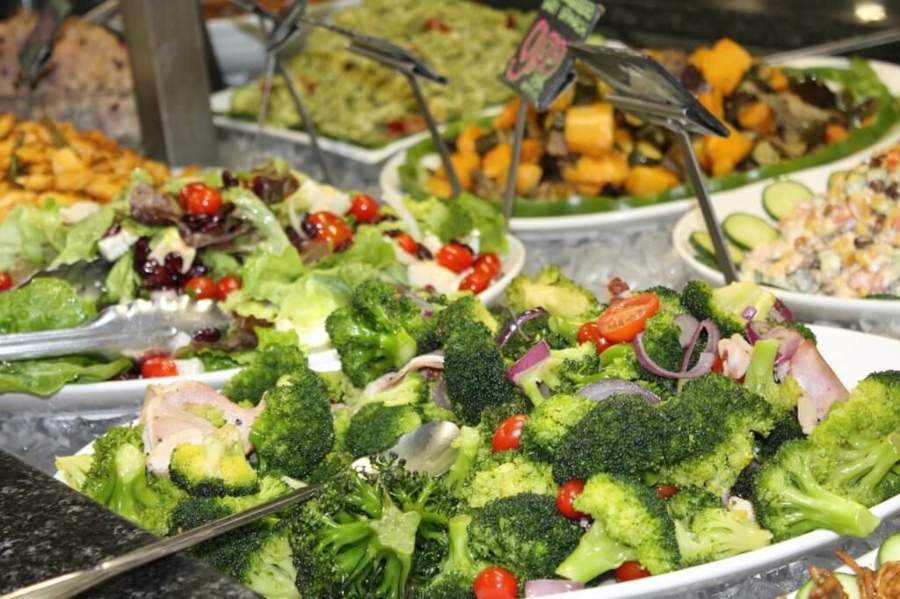When it comes to food, your ability to prepare, present and dispose of your produce appropriately can be a matter of life or death: The amount of people who suffer from food allergies is on the rise, and as highlighted by the tragic death of a Pret a Manger customer, food safety awareness should be of the utmost concern to commercial kitchen caterers.
Below, we offer practical tips, as well as a Food Allergens Poster for you to use in your licensed Commercial Kitchen, to help you to make sure that your staff fully understand what goes into each of your food products, how these foods should be handled, and how to provide the right information on pre packaged and unpackaged food to the consumer.
Train Your Staff

People asking for clarification on what is in their food aren’t fuss pots. You need to be genuinely concerned for your customers’ well being and to help them as far as possible with their food choices. To do this you need to make sure that all staff know EXACTLY what goes into EVERY meal and that they understand how allergens work. Which is where training comes in.
This doesn’t just apply to chefs, but also KPs, waiters, front of house teams and the person managing the till. It cannot be exaggerated enough that all staff, even if they “only” serve food, need to know what allergens are and how important it is to make sure that consumers know what they are eating.
The Food Standards Agency offers a free food allergy training course online that we would recommend all staff are encouraged to take. As well as encouraging the correct handling, labelling and understanding of allergens we also think that staff should be provided the option by employers to know what to do if a consumer has a severe reaction to food produced by your commercial kitchen. St John’s Ambulance offers Anaphylaxis first aid courses as well as fantastic online advice for how to recognise and treat severe allergic reactions.
What Is An Allergy?

According to the NHS, “allergies occur when the body’s immune system reacts to a particular substance as though it’s harmful”. Allergies are relatively common and affect 1 in 4 people in the UK. Whilst these allergies are often mild, some people can have severe and life threatening allergies. The substances that cause allergic reactions are called allergens and can range from pollen, to insect bites and stings, to food.
Allergies are different from an “intolerance” or “sensitivity”. An allergic reaction is produced by the body’s immune system, such as sneezing, a red and itchy rash or wheezing. An intolerance might cause sickness or diarrhoea, but won’t be brought on by the immune system. A “sensitivity” will exaggerate the normal effects of a substance.
Symptoms Of An Allergic Reaction

The substances that cause allergies are called allergens. People with allergic reactions should avoid coming into contact with the allergens that they are affected by. Most allergic reactions are mild such as an itchy rash or sneezing, and those people who suffer from the allergy will be able to manage it by using antihistamines, decongestants or steroids.
However some people’s reactions can be life threatening, causing anaphylaxis or anaphylactic shock – symptoms can occur within seconds of coming into contact with the allergen which requires immediate medical attention.
What Are The Key Allergens To Be Aware Of and Why?

Allergens are classified under 14 groups. You need to ensure that you handle these allergens carefully and that you ensure that your consumers know if they appear in their food:
- Celery (including celeriac)
- Cereals containing gluten, namely: wheat (such as spelt and khorasan wheat), rye, barley, oats
- Crustaceans for example prawns, crabs, lobster, crayfish
- Eggs
- Fish
- Soybeans
- Milk (including lactose)
- Peanuts
- Nuts; namely peanuts almonds, hazelnuts, walnuts, cashews, pecan nuts, Brazil nuts, pistachio nuts, macadamia (or Queensland) nuts
- Mustard
- Sesame
- Sulphur dioxide/sulphites, where added and at a level above 10mg/kg or 10mg/L in the finished product. This can be used as a preservative in dried fruit
- Lupin, which includes lupin seeds and flour and can be found in types of bread, pastries and pasta
- Molluscs like mussels, whelks, oysters, snails and squid
What Kind of Caterer Are You?

The way that food is presented to customers changes the laws on how you describe the allergens involved. This can be broken down into:
- “Pre-Packaged Food” – Food that is partially or fully packaged prior to sale.
- “Non Pre-Packaged foods”:
- “Loose” food items – Food bought “loose” for example in a supermarket, deli or butcher
- “Direct Selling” – Food sold direct from a commercial kitchen such as a restaurant or cafe
- “Distance Selling” – Food created for takeaway or delivery, for example in a dark kitchen
The Food Standards Agency provides detailed labelling guidelines for commercial kitchen food providers to ensure that food manufacturers provide the right information in the right way for their consumers.
In March 2019 the government launched a consultation to discuss whether amendments needed to be made to these laws following tragic fatalities as a result of consumers being badly informed on the content of their food. As a result it is important to ensure that your team continues to monitor this progress to ensure that you offer the right information to your customers.
Regardless of these regulations, it really should be a no brainer that you notify consumers of any allergens contained in your food, or that the food may have come into contact with in the food preparation process. Download our Allergen Poster and fill it in for all your staff to use in the kitchen – and put it on your website for users to get to grips with all that goes into your food.
Handling Food Allergens In Your Commercial Kitchen
As well as offering information to your consumers about what is in their food, it is important to consider the preparation process and to ensure that there is no risk of allergens contaminating products. This can be done by:
- Separating work surfaces/chopping boards/utensils etc. for meals prepared with certain allergens
- Storing food produce containing allergens separately in closed containers that are clearly labelled- as you would raw and cooked meat, for example
- Maintaining basic hygiene for all staff – especially with regard to washing hands
- Thoroughly cleaning any implements that have been used for cooking items with allergens

Key Takeaways
Allergies aren’t intolerances or sensitivities, they are sometimes life threatening conditions. Whilst most people with an allergy will only show mild symptoms, you never know when the next person that walks through your door/orders online/buys from their local cafe is that one person that might die from an ignorant staff member handling food that contains an allergen.
Making sure that you, your team, and all that come into contact with the food that you produce are up to speed with what food allergens are, which ones are in your food products and how to handle, label and dispose of them might just be the difference between life and death.
Learn More
If you’re keen to stay on top of best practice in the kitchen take a look at our latest guides: